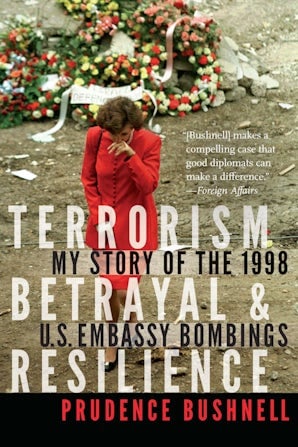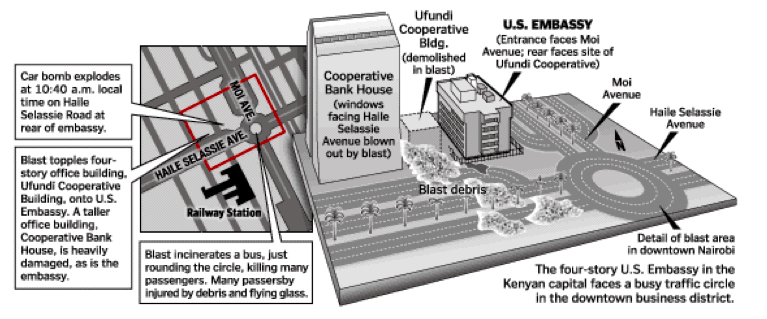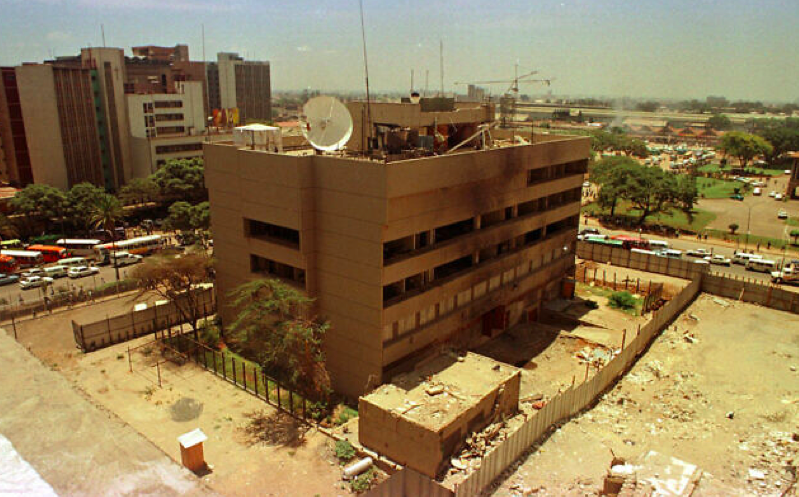The 1998 Bombings of Two U.S. Embassies in Africa: “Terrorism, Betrayal and Resilience” by Prudence Bushnell
Book review

All Global Research articles can be read in 51 languages by activating the Translate Website button below the author’s name.
To receive Global Research’s Daily Newsletter (selected articles), click here.
Click the share button above to email/forward this article to your friends and colleagues. Follow us on Instagram and Twitter and subscribe to our Telegram Channel. Feel free to repost and share widely Global Research articles.
***
“I do not have a clear picture yet of what happened when“, “I may not ever have a clear picture of what happened when. None of us may.” — Prudence Bushnell, “U.S. Case Against bin Laden in Embassy Blasts Seems to Rest on Ideas”, New York Times, April 13, 1999
Prudence Bushnell’s book “Terrorism, Betrayal & Resilience” is an unexpected source of stunning inside information about the 1998 bombings of the two American embassies in Africa. Bushnell’s book, published twenty years after the bombings, attracted little notice but it raises key questions about what the U.S. role in the bombings might have been. The 25th anniversary of these bombings is August 7, 2023.
On the morning of August 7, 1998, there were virtually simultaneous truck bomb explosions at two American embassies in Africa that were over 400 miles apart. The bombings, at Nairobi, Kenya and Dar es Salaam, Tanzania, killed over 250 and injured over 5,000; they occurred in countries which were allied to the U.S. and had been regarded as generally peaceful.
The Nairobi bombing, in which the vast majority of the deaths and injuries occurred, took place in the parking lot behind the embassy. While the back of the embassy building was merely scorched and its windows blown out, the explosion destroyed the seven- story Ufundi House office building (reportedly steel and concrete) in front of the truck as well as busses and traffic behind the truck. Hundreds of businesses along the street were damaged and many of the injuries included amputations and blindness.
Bushnell notes that despite the dozen U.S. agencies in the blast area, only 12 of the approximately 250 victims who died were American. The U.S. decided to destroy the embassy building despite its light damage.
The U.S. quickly blamed Osama bin Laden and al Qaeda for the bombings. The first embassy bombing trial would take place in New York City because the U.S. had filed a secret indictment against bin Laden (and about 20 others) two months before the embassy bombings for attacks on Americans over the past decade. The indictment would be updated in November, 1998, to include the embassy bombings. The trial, at which only the four charged with the embassy bombings would be tried, was held in 2001; they were convicted in May and sentenced to life in prison the following October, the month after 9/11.
Prudence Bushnell was serving as the U.S. ambassador to Kenya at the time of the Nairobi embassy bombing. When the explosion happened, she was in the Cooperative Bank building near the embassy which was not severely damaged, but she was traumatized by the experience and clearly disturbed by what she saw from her position as ambassador. The word “betrayal” in her book’s title seems to be the key to understanding why she wrote this book.
While Bushnell adopts a breeziness about her experiences — we learn that she is a great dancer, has a neat husband and lives in a big house – what she has to relate is significant. She covers her critical observations by affirming her support for the way the U.S. government does business: rendition, torture and even assassinations are acceptable tools, and she accepts that Osama bin Laden and al Qaeda are responsible for terrorism and for the bombings. She loses some credibility with unreliable background information on Wadih el Hage and the Alkifah Center along with extensive footnotes which are not always reliable.
She weaves into her account, however, information that challenges assumptions about the bombings. She is disturbed by President Bill Clinton’s directives, by the strange American response to the Nairobi victims, by the unexpected U.S. disinterest in bombing information, and by the veiled apology she received from the prosecutors at the 2001 New York trial.
Bushnell notes that many Africans were skeptical about U.S. claims that it had been attacked by anyone. Bushnell’s issues include:
- President Bill Clinton’s foreknowledge
President Bill Clinton called Ambassador Bushnell immediately after the Nairobi explosion:
Ambassador, someone yelled, the president wants to talk to you… How are you? he asked. … Pru, he continued, “I want you to secure the perimeter!”
What? Really? I could hardly believe my ears. Where was the famous “I feel your pain”?… I answered hesitantly, thinking, why is he talking about this? “Mr. President, we’re still bringing out bodies.”
“Oh.. well.. okay. But as soon as you can, secure the perimeter and … hold on a second. .. and you need to secure the perimeter of the building next door, too.”
But Mr. President, I argued, “They are digging out bodies there, too, from the rubble.”
Oh, okay, But as soon as possible, secure the perimeter!” he ordered.
… I was far too dumbstruck by the instruction. … We hung up without further conversation.
“Terrorism Betrayal & Resilience” pp. 14-15
The implications of Clinton’s response are stunning on two accounts.
- Clinton is aware that Ufundi House — “the building next door” — was involved in the embassy bombing operation; and
- Clinton’s command to “secure the perimeter” while people were buried alive inside them demonstrated that he knew that the purpose of the bombing trumped rescuing trapped people. That command was why Americans protected the ruins — even by threatening first responders — rather than helping to save people’s lives.
- The U.S. focus on protecting wreckage rather than helping buried victims
Under the dire circumstances, U.S. personnel would have been expected to help rescue the trapped victims; instead, Bushnell notes that Marines threatened first responders and took no part in rescue operations; they were concerned only with protecting the remains of the buildings — presumably to allow the analysis of the explosive residue. US medical personnel were called in, apparently to perform autopsies on the dead rather than to aid the injured.
Bushnell was disappointed that the U.S. not only ignored the African victims on August 7th, but would largely wash its hands of helping them afterward, claiming that it was not responsible for the bombing.
- The U.S. refusal to interrogate those who knew about the embassy bombings
Bushnell notes the official dismissals of the several men who warned about the bombing. Mustafa Mahmoud Said Ahmed walked into the Nairobi embassy in November, 1997 and gave a detailed and accurate description of what would happen the following August. The CIA dismissed his warning but interestingly, according to Bushnell, would meet with him “within a week” of the August 7th bombings. He was arrested after the bombings, but instead of facing U.S. interrogation or extradition, he was “deported to Egypt, never to be seen again.” (p. 183)
U.S. investigators did not ask Bushnell for her witness and they were dismissive of African investigations, including of the suspects held by Nairobi and Dar es Salaam police. Highly-respected Sudanese intelligence had arrested two people it believed were connected to the bombings and held them for the U.S., assuming that they would want them. The U.S. was not interested, so the Sudanese released them. (p. 183)
- The U.S. government’s presumed foreknowledge from its surveillance
Although Bushnell was shocked by the amount of information the U.S. had on al Qaeda in its November, 1998 indictment, she should not have been because she did document that the CIA, the FBI and the NSA had long had al Qaeda members under surveillance. Osama bin Laden (including his satellite telephone) had been under surveillance since 1993. Wadih el Hage, who led al Qaeda in Nairobi and was among those first charged, had had his computer, phone and address book confiscated in an August 1997 FBI raid on his home; he followed the FBI “advice” to leave Nairobi and return to the U. S., although it wouldn’t save him. El Hage was associated with U.S. intelligence agent Ali Mohamed, whose computer was downloaded and his home wired and phone bugged in 1997. [This is the same “Green Beret” whose military classes in New Jersey had drawn in those who would be convicted of the 1993 World Trade Center bombing conspiracy! Mohamed would plead guilty to a minor scouting role in the embassy bombings and was allowed to disappear before sentencing.]
- The “veiled apology” from the prosecutors of the 2001 trial
“The Wall”, the prosecutors explained, did not allow those in the know to communicate warnings.
Bushnell leaves it up to the reader to analyze the implications of her information on the U.S. government’s role in — or use of — the embassy bombings operation. She draws no controversial conclusions. Despite the evidence at the U.S. government’s disposal that should have anticipated the bombings, her book claims that the bombings were an “intelligence failure”.
Given her evidence, the embassy bombings were either intelligence failures that demonstrated the willful incompetence of U.S. security organizations or successful false flag operations perfectly timed to further various agendas — including obtaining al Qaeda convictions four months before 9/11 that facilitated NATO’s unanimous support for its “War on (‘al Qaeda’) Terror”.
Bushnell lays out the evidence.
*
Note to readers: Please click the share button above. Follow us on Instagram and Twitter and subscribe to our Telegram Channel. Feel free to repost and share widely Global Research articles.
Karin Brothers is a freelance writer. She is a regular contributor to Global Research.



